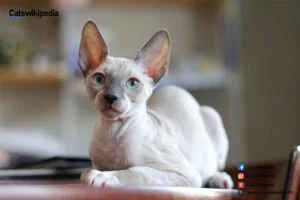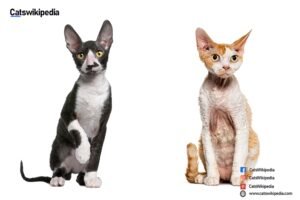Cornish Rex
INTRODUCTION
The Cornish Rex is one of those breeds of domestic cats that is somehow different in its look and behavior. This breed could not go unnoticed due to its wavy hair, energetic nature, and relatively long history. It is a favorite among most cat fanciers.

It researches this great breed’s care requirements, characteristics, history, and much more.
CORNISH REX’S HISTORY
It began in Cornwall, England, in the 1950s with the Cornish Rex. Technically speaking, the story concerning the breed traces its origin back to just one kitten born to Serena, a stray tortoiseshell cat notable for giving birth to a kitten with a wavy coat, which gave rise to the Cornish Rex breed.
Initial interest in Kallibunker’s coat soon turned to careful breeding to understand the trait genetically and attempt to reproduce it. As with the names of other related breeds, such as the Devon Rex, the breed was named after the county where it originated, Cornish, and “Rex,” Latin for “king,” was added to indicate the curly fur. The Cornish Rex achieved official recognition and saw its first surge in popularity in cat fancier circles by the 1960s.

CHARACTERISTICS
The Cornish Rex cat is undoubtedly one of the most recognizable because of its peculiar coat and refined build:
– Coat
The Cornish Rex’s coat is perhaps its most distinctive feature. It is short, soft, and wavy, lacking the guard hairs found in most cats. The cat’s entire body is covered in uniform curls that give it a distinctive, fluffy look. The coat is available in many hues and designs, and many people compare its texture to velvet or lambswool.
– Body
Its slender muscular frame contributes to its elegant, graceful, and athletic aspect. Cornish Rex has a deep chest, small waist, and is of length and slender at the neck. The legs are longest and thinnest, standing attractively.
– Head
The head is medium-sized with a well-defined, curved outline. The eyes are large and almond-shaped; thus, they look overly expressive and inquiring in all circumstances. The ears are big and set high, making them appear alert, attentive, and listening to something.
– Size
Cornish Rex cats are of medium size. Males weigh about 6 to 10 pounds, and females about 5 to 8 pounds. Physically, Cornish Rex cats look sleek in body shape, but as surprising as it may seem, they are pretty muscular and sturdy.
PERSONALITY AND TEMPERAMENT
The Cornish Rex has acquired a name for being an extroverted, playful, friendly cat. Basically, these social cats love nothing more than spending as much time as possible with their human companions.. Because of their devotion to their owners and their excitement for sports and activities, they have frequently been referred to as “dog-like.”
Playfulness
To keep their minds and bodies engaged, lively Cornish Rex cats require frequent playtime. They love interactive toys and climbing structures and respond very well to learning tricks. Their playful nature makes them a great fit with children or other pets in the family.
Affectionate
They are affectionate cats who show their love. Most of the time, they want to be attended to by their owners and like being involved in family activities. They’ll likely follow their humans around the house, jump into their laps, or snuggle beside them at night.
Intelligence
The Cornish Rex is intelligent and curious. They are swift learners, so owners find them relatively easy to train to use their litter or even master some tricks. The cat’s inquisitive nature will need mental stimulation; otherwise, it will get bored.

CARE AND GROOMING
The care of the Cornish Rex cat includes attention to its unique coat and needs for social and physical stimulation:
Grooming
One of the major plus factors of the Cornish Rex coat is that it requires very little maintenance. While many long-haired breeds mat and need regular brushing, the Cornish Rex’s coat does neither. The skin is somewhat exposed to environmental elements due to a lack of guard hairs. Gentle wiping with a damp cloth will remove any dirt or oils.
Overall, Cornish Rex cats are healthy, but issues caused by their genetic background do occur. They can be subject to hereditary conditions like HCM, the most common feline heart condition. A veterinarian should regularly check their health, and they should have a balanced diet.
– Diet
A good diet is the central part associated with the health of the Cornish Rex. Excellent quality cat food should be fed, which provides them with all nutritional requirements. Due to their nature, they might need a slightly higher caloric intake than other less active breeds.
– Exercise
Cornish Rexes are energetic breeds requiring frequent exercise. Playtime and perfect toys should keep them in good shape and interested in life. Active play, like using feather wands or laser pointers, can be very successful in this breed.
LIVING WITH A CORNISH REX
The Cornish Rex is fine in apartments and large homes. Due to its playful but tender nature, it is appropriate for families and single owners alike.
– Socialization
They get along well with other pets, even dogs, especially those exposed early. Their social nature means they generally get along with other animals and adapt to new situations quickly.
– Environment
Though they do well in most situations, they require a comfortable and stimulating space. Because they are not insulated with fur, they may be more sensitive to extreme temperatures. Provide warmth and a cozy place to sleep and rest.

CONCLUSION
One of the most exciting and engaging breeds, the Cornish Rex, will bring beauty and personality into any home. Known for their wavy coat, playful behavior, and affectionate nature, they will be great companions if a person can satisfy their social and physical needs. Knowing their history, characteristics, and the type of care they require is essential in keeping a Cornish Rex healthy and happy as a family member for many years. Whether it be the spectacular looks or the lively, saucy, and playful personality, there is something about a Cornish Rex that demands a piece of your heart.






